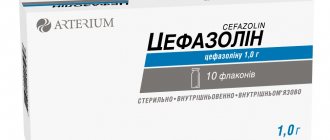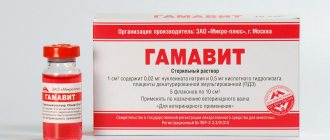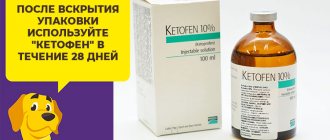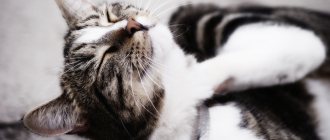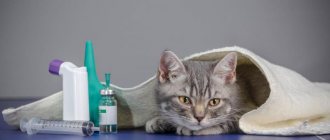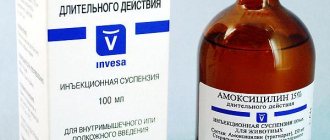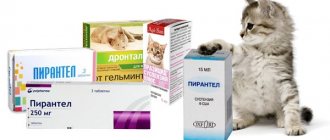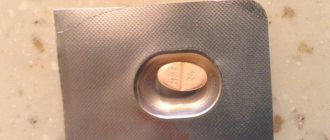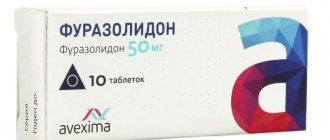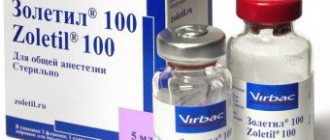7370Pavel
Nowadays, antibiotics are becoming increasingly popular in veterinary medicine. They have become indispensable assistants in the treatment of various diseases. Although it is worth recognizing the fact that most of these drugs cause irreparable harm to the body of four-legged animals. One of these antibiotics is Gentamicin for cats. On the one hand, it destroys harmful bacteria, and on the other, it negatively affects the internal organs of the pet.
Still, let's try to figure out what is more good or harmful from Gentamicin? And how should you take this remedy correctly so that you don’t have to deal with a lot of problems related to your cat’s health?
© shutterstock
Release form and method of use
Available in the form of an injection solution. The liquid should be colorless, but a slightly yellowish tint is allowed. Under no circumstances should a solution be used to treat animals if it contains at least a minimal amount of impurities or the presence of sediment is observed! The medicine is packaged in 2/5/10 ml ampoules and 50 ml dark glass bottles (there are other variations, it all depends on the manufacturer). One milliliter of solution contains 40 mg of active substance.
It is administered intramuscularly only. The product is characterized by good absorption in the body, the maximum concentration in blood plasma and other biological fluids is achieved in just an hour. This content of the drug components remains in the animal’s body for 10-12 hours. A positive feature of gentamicin is its penetration into the pleural and abdominal cavity, which makes it possible to use the drug for the treatment of pleurisy and peritonitis (caused by gram-negative microorganisms, of course). A negative feature is that it penetrates the placental barrier just as easily, so you should not use the medicine to treat pregnant cats.
As we have already said, the drug should be administered exclusively intramuscularly, paying special attention to the rules of asepsis. What is the dosage of gentamicin for cats? On the first day, a dose of 1.1 ml is administered for every 10 kg of live weight per day. Frequency of application – twice a day. Since there are few such giants among cats, it is better to administer the medicine at the rate of 4.4 mg of active substance per kilogram of live weight. As in the previous case, the drug should be used twice a day.
Starting from the second day of treatment, the drug is used once a day, the dosage remains the same. What dosage is used for kittens? It is strongly not recommended to treat newborn animals with this remedy. In extreme cases, when there is nothing more suitable at hand, the antibiotic is taken in a half-reduced dose (that is, 2.2 mg per kilogram of live weight). The maximum duration of treatment is five days. It is strictly forbidden to administer the drug with a non-sterile syringe, or with a syringe with traces of other drugs on the walls. In this case, the risk of developing side effects, as well as abscesses and other inflammatory reactions, is very high.
Important! Some veterinarians administer the drug intravenously along with saline through a catheter. However, this method is not described in the instructions for the drug and its use depends on the experience and competence of the veterinary clinic staff.
This is interesting: How to give calcium gluconate to cats?
Directions for use and doses
They are set individually, taking into account the severity and localization of the infection, and the sensitivity of the pathogen.
When administered intravenously or intramuscularly for adults, the single dose is 1-1.7 mg/kg, the daily dose is 3-5 mg/kg; frequency of administration - 2-4 times/day. The course of treatment is 7-10 days. Depending on the etiology of the disease, it is possible to use a dose of 120-160 mg 1 time / day for 7-10 days or 240-280 mg once. IV infusion is carried out over 1-2 hours.
For children over 2 years of age, the daily dose of gentamicin is 3-5 mg/kg; frequency of administration - 3 times/day. Premature and newborn babies are prescribed a daily dose of 2-5 mg/kg; frequency of administration - 2 times/day; Children under 2 years of age are prescribed the same dose at a frequency of administration 3 times a day.
When applied topically, gentamicin is instilled 1-2 drops into the lower conjunctival sac of the affected eye every 1-4 hours.
For external use, apply 3-4 times a day.
Maximum daily doses:
for adults and children with intravenous or intramuscular administration - 5 mg/kg.
Indications for use
The list of possible use cases is quite wide:
- Many respiratory infections of the upper and lower respiratory tract.
- Diseases of the urinary system, including nephritis and cystitis of bacterial etiology.
- Arthritis and arthrosis caused by gram-negative pathogenic microflora.
- Gentamicin for animals has proven itself well in the treatment of even severe forms of peritonitis .
- Pleurisy , pneumonia , etc.
We remind you once again that before prescribing a medicine, it is necessary to accurately determine the type of pathogen: Gentamicin for cats is not a broad-spectrum antibiotic!
Please note the list of possible side effects:
- an allergic rash occurs , which disappears soon after stopping the medication.
- In more rare situations, intermittent fever may develop . If it is detected, administration of the drug should be stopped immediately!
- If the medicine is used for more than 6-7 days, the development of severe destructive damage to the kidneys and nervous system is very likely . The kidneys are especially affected, and acute kidney failure may develop. In many cases of overdose, it ends in the death of the affected animal.
For what diseases is treatment prescribed?
No matter how much you think you know exactly what the cat is sick with, self-treatment with this drug is strictly prohibited. Unless, of course, you want the cat to die in your arms. You should definitely visit a veterinarian. Moreover, you can inject Gentamicin into a cat only when it comes to gram-negative bacteria, otherwise this medication will be of no use. And it will be possible to determine the type of bacteria that are present in your cat’s body thanks to a special culture, which will be done by a specialist.
Veterinarians attribute this medicine to the presence of many diseases, which include:
- Various respiratory tract infections.
- Problems of the urinary system, including nephritis and cystitis.
- Arthritis and arthrosis, which are provoked by the presence of pathogenic microflora in the cat’s body.
- Peritonitis, pneumonia, and other diseases that occur due to gram-negative bacteria.
And remember, injecting a cat with Gentamicin is not an easy task at all, since injections of such a drug are very painful. Therefore, the animal must be held very tightly. To carry out this procedure, you should take an assistant or use a special retaining bag.
special instructions
Before starting treatment with Gentamicin injection solution, be sure to take into account special instructions regarding its use, which include:
- Manifestations of impaired functional activity of the kidneys or auditory nerve require immediate discontinuation of the drug.
- Gentamicin injection solution should be used with caution in young children.
- If it is necessary to administer the drug to a nursing woman, the child is transferred to artificial feeding with an adapted milk formula while using the Gentamicin solution.
- During the course of treatment with Gentamicin injection solution, periodic laboratory monitoring of the main biochemical indicators of the functional activity of the liver and kidneys is required.
- Under constant medical supervision, the drug is prescribed to patients with concomitant dehydration (dehydration) and myasthenia gravis (muscle weakness).
- The drug may interact with drugs from other pharmacological groups, in particular when administered together with loop diuretics (diuretics), its negative effect on the kidneys may be enhanced.
- The drug does not affect concentration and speed of psychomotor reactions.
In the pharmacy chain, Gentamicin injection solution is available with a doctor's prescription. It is not recommended to use the drug independently or on the advice of third parties.
Contraindications
According to the instructions, do not use in dogs with hypersensitivity (allergy) to aminoglycosides. Ineffective against most anaerobic bacteria (those microorganisms that can live without oxygen). Do not use dogs that require acute hearing to perform their job (working breeds, military dogs, police dogs, guide dogs, guard dogs, etc.). Since hearing or vestibular (balance) impairment may be irreversible.
- Do not use gentamicin in dogs with kidney disease, as this group of medications may worsen the disease if present.
- Not for use in pregnant or nursing dogs.
- Not for use in dogs with myasthenia gravis or other neuromuscular disorders.
- Not for use in dogs with fever or dehydration.
Dosage
Instructions for the use of Gentamicin for cats state that the drug is administered carefully, adhering to the established regimen:
- On the 1st day, the drug should be administered at a rate of 1.1 ml per 10 kg of animal weight. Do this procedure 2 times a day.
- On the 2nd and all subsequent days, the dosage of Gentamicin for the cat remains the same, only the drug must be injected once a day.
Some veterinarians administer Gentamicin intravenously to cats using a catheter. But this is a rather complicated procedure and the instructions say nothing about it. Therefore, such injections can only be performed by a top-class professional. Ordinary people or beginners in this business should not perform such a dangerous trick. And the point is not at all that not everyone can install a catheter correctly. It’s just that not everyone will be able to calculate the dosage of the drug and take into account the fact that when administered intravenously, Gentamicin penetrates the body almost at lightning speed and easily reaches high concentrations.
This is interesting: Heptral dosage for cats
pharmachologic effect
Gentamicin is an antibiotic that belongs to the pharmacological group of aminoglycosides. It has a bactericidal effect (destroys bacterial cells) due to blockade of the 30S subunit of the bacterial ribosome. This leads to disruption of intracellular protein synthesis and death of the bacterial cell. The most sensitive to gentamicin are gram-negative (Gram-stained pink) bacteria. The drug is not effective against streptococci and anaerobes (bacteria whose life activity is possible only in oxygen-free conditions).
After parenteral administration, gentamicin quickly reaches a therapeutic dose in the blood and is evenly distributed in all tissues of the body. It penetrates the blood-brain barrier into the structures of the central nervous system. During pregnancy, gentamicin can enter the developing fetus. During breastfeeding, the antibiotic passes into breast milk. The active substance of the drug is metabolized in the liver, breakdown products are excreted from the body by the kidneys and urine.
Contraindications
Contraindications for Gentamicin mainly relate to the complete incompatibility of the drug with other drugs. Gentamicin is prohibited from being used simultaneously with penicillins, other aminoglycoside antibiotics, some cephalosporins, chloramphenicol, polymyxin, colistin, and sulfonamides. In addition, the following are contraindications:
- Renal dysfunction;
- Hypersensitivity to gentamicin;
- During pregnancy;
- Use with other nephrotoxic and ototoxic drugs;
- Use with some anesthetics (halaton);
- Use with muscle relaxants.
Drug overdose
If you do not adhere to the dosage while using this medication or exceed the time limit for using Gentamicin, then an overdose of this drug may occur. Such poisoning may have a negative impact on your pet's hearing and kidneys. He may also experience an allergic reaction, which will be accompanied by a rash and itching. Problems with the eighth cerebral nerve are also possible.
And most importantly, remember that long-term use of Gentamicin has a very bad effect on the cat’s body. If you use this medication for more than 7 days, severe destructive damage to the kidneys and nervous system may occur. But most often the development of acute renal failure occurs. In most cases, such problems lead to the death of a pet.
TOXICOLOGY
Gentamicin injection solution affects vestibular and renal functions in animals and humans.
Chronic administration of 5 mg/kg for 50 days in dogs, 10 mg/kg for 40 days in cats, and 20 mg/kg for 24 days in rats resulted in moderate toxicity in some animals studied. Higher toxic doses result in renal and vestibular damage that appears to be dose related. In humans, the only serious side effect to date has been damage to the eighth cranial nerve, predominantly the vestibular branch. When the dose of gentamicin was exceeded, the animals developed proteinuria, an increase in the content of urea nitrogen and creatinine in the blood serum. These results usually returned to normal after discontinuation of the drug.
Gentamicin toxicity was not observed in neonatal pigs that were administered gentamicin at three times the recommended dose for 15 days. During clinical studies in piglets under three days of age, no side effects were observed.
The LD50 of gentamicin for one-day-old turkey poults is calculated to be 27.8 mg per male and 40.5 mg per female.
^Top
Side effects, contraindications
The most common side effect of antibiotics is a disruption of the intestinal microflora (dysbacteriosis). Drugs in this group have a detrimental effect not only on pathogenic, but also on beneficial microorganisms.
This side effect can be neutralized by the simultaneous intake of probiotics, which populate the intestines with the necessary microflora.
It is recommended to give them to the cat for another 2 weeks after completion of antibacterial treatment.
Be sure to read:
Canephron for cats: instructions for use, price, reviews, analogues
Other adverse reactions to taking antibacterial drugs may include:
- Allergy to the active substance or auxiliary component (rash, scratching on the skin, focal hair loss).
- Edema of an immunological nature.
- Spasms and convulsive contractions of muscles.
- Breathing disorders, up to suffocation.
- Vomiting, diarrhea, stomach pain.
Antibiotics can affect the reproductive system, so at least 3 months should pass between the end of treatment and the mating of the cat. Otherwise, the offspring may be born with defects.
Antibiotics are used in the treatment of any infectious diseases.
If a cat has liver and kidney diseases, antibacterial drugs can cause their exacerbation.
In case of disturbances in the functioning of these excretory organs, taking the aminoglycoside monomycin is absolutely contraindicated, and in case of some skin diseases, bacteriostatic drugs such as chloramphenicol and syntomycin are prohibited.
The period of pregnancy and breastfeeding is also a contraindication to antibiotic therapy. Treatment of kittens should be carried out under the supervision of a veterinarian.
Purpose and possible restrictions
Polyarthritis in an animal is one of the indications for prescribing this drug.
Injections with Gentamicin solution are indicated for cats and female cats in which the following pathological conditions were identified during a diagnostic examination:
- dermatitis;
- respiratory diseases;
- nonspecific infectious inflammatory kidney disease;
- polyarthritis, arthritis;
- diffuse inflammation of the peritoneum;
- sepsis;
- gastrointestinal infections.
However, it is not always permissible to inject Gentamicin into a cat. The medication is strictly contraindicated if the pet has an individual intolerance to its components. In addition, the medicine cannot be administered if the purr is simultaneously being treated with cephalosporins, Polymyxin, penicillins, Colistin and other aminoglycoside antibiotics. The medication is also contraindicated for newborn kittens, pregnant and lactating individuals, as well as pets with impaired renal function.
Gentamicin for cats
The pharmaceutical drug “Gentamicin” for cats is actively used in veterinary medicine. However, this antibacterial drug causes a lot of controversy among veterinarians and scientists involved in the issue of treating animals with human medicines.
On the one hand, the antibiotic has a detrimental effect on pathogenic microorganisms, and on the other, it has a negative effect on the internal organs of cats.
Thus, before using Gentamicin for your four-legged pet, you should definitely consult with a veterinarian and study the instructions for use included with the medicine.
Composition and mechanism of operation
An aminoglycoside antibiotic with a broad spectrum of antimicrobial action, Gentamicin, is active against many gram+ and gram- bacteria.
In veterinary medicine, it is used for the treatment of cattle, domestic animals, pigs and horses. In one of the scientific articles published in the journal in 2015, E. Yu. Kukaeva describes the effective treatment of viral infections of cats and the pointlessness of taking antibiotics for their treatment.
This is due to the fact that the active component of the medicine does not act against viruses, as well as fungi, anaerobic bacteria and protozoa.
“Gentamicin” is sold in the form of a solution, which, through injection, perfectly penetrates into all tissue structures and organs of the cat’s body, reaching its maximum concentration in the blood within 60 minutes after manipulation. The therapeutic effect lasts up to 12 hours.
Purpose and possible restrictions
Polyarthritis in an animal is one of the indications for prescribing this drug.
Injections with Gentamicin solution are indicated for cats and female cats in which the following pathological conditions were identified during a diagnostic examination:
- dermatitis;
- respiratory diseases;
- nonspecific infectious inflammatory kidney disease;
- polyarthritis, arthritis;
- diffuse inflammation of the peritoneum;
- sepsis;
- gastrointestinal infections.
However, it is not always permissible to inject Gentamicin into a cat. The medication is strictly contraindicated if the pet has an individual intolerance to its components.
In addition, the medicine cannot be administered if the purr is simultaneously being treated with cephalosporins, Polymyxin, penicillins, Colistin and other aminoglycoside antibiotics.
The medication is also contraindicated for newborn kittens, pregnant and lactating individuals, as well as pets with impaired renal function.
Instructions for use
The course of treatment for a pet lasts up to 5 days through injection of the drug.
The method of use and dosage is determined by the veterinarian personally for each cat, after its examination and diagnosis.
“Gentamicin” in the form of a solution is usually prescribed to purrs at 1.1 ml per 10 kg of pet’s weight every 12 hours. Then the cat is given an injection at the same dosage once a day until complete recovery. This often takes up to 5 days.
It is better for a newborn kitten to abstain from this antibiotic, but if this is not possible, then the adult dose will need to be reduced by exactly 2 times.
Do not mix different medications in one syringe.
Negative phenomena
In most cases, treatment of cats with Gentamicin proceeds well, but occasionally, injections with an antibiotic can provoke allergic reactions, manifested in the form of skin rash, fever, and itching.
Long-term use of the drug entails a violation of the functional ability of the eighth cerebral nerve.
Some veterinarians are against treating cats with Gentamicin because they believe that this antibacterial drug can cause problems with the pet’s kidneys and ears.
The toxic effect of the drug on your pet's kidneys can be avoided if it is used correctly.
This opinion is quite possible, since the medication has nephrotoxic and ototoxic effects.
Therefore, antibiotics for cats should be used with extreme caution and should never be administered to pets without the knowledge of a veterinarian and for the purpose of prevention.
With the correct administration of Gentamicin and strict adherence to the doses recommended by the instructions for use and the veterinarian, you don’t have to worry about negative consequences.
What to replace it with?
Not only Gentamicin, but also other pharmaceuticals with antibacterial activity can be used to treat pets. And most often, to replace the medication in question, veterinarians prescribe the following antibiotics, which are as safe as possible for cats:
- "Doreen";
- "Clamoxil";
- "Kobaktan";
- "Lincomycin";
- "Sulf";
- "Sinulox";
- "Amoxoil retard";
- "Amoxicillin";
- "Stomorgil."
In what cases is it prohibited to give the drug?
You should also pay attention to the fact that in some situations it is completely prohibited to give Gentamicin injections to cats. The most common of them include:
- Pregnancy. The drug penetrates the placental barrier very quickly, so it can cause irreparable harm to the baby.
- Lactation period, since Gentamicin sulfate, together with milk, easily penetrates the kitten’s body.
- A non-sterile syringe that contains drug residues, because it is difficult to predict the interaction of this drug with them. As a result, such a compound can cause inflammation and various side effects.
- Having kidney problems.
- Taking a variety of drugs that are nephrotoxic, muscle relaxants and ototoxic medications.
- Greater sensitivity to Gentamicin.
- Very young age. Giving this antibiotic to a newborn kitten is strictly not recommended. And only in very rare cases, with the permission of a specialist, can the solution be administered intravenously. That is, it is necessary to reduce the dose of this medication by 2 times.
As you can see, Gentamicin is a rather dangerous medical drug that should not be joked with. But still, situations may arise in a cat’s life when he will be simply irreplaceable. Therefore, you should not be afraid of using Gentamicin; the main thing is to strictly adhere to the instructions for using this drug, and also carry out this type of treatment under the supervision of a good professional. Then everything will definitely be just fine for you and your cat.
Antibiotic therapy is sometimes the only chance for an animal to recover from a severe bacterial infection. Without these tools, it is simply impossible to imagine modern medicine and veterinary medicine. Unfortunately, many modern antibiotics are rarely affordable, and therefore owners of sick animals often look for a cheaper but effective alternative. Gentamicin is an inexpensive and quite “working” antibiotic.
Advantages and disadvantages of antibiotic therapy in cats
Official instructions, analogues, side effects, use during breastfeeding, pregnancy #Indicated…
The main advantages include:
- reduction of treatment time for the disease, ease of administration, low effective dosages (some antibiotics are used in short courses with a single injection due to their action);
- rapid improvement in the pet’s condition;
- the presence of broad-spectrum properties (when there is no time or opportunity to determine the sensitivity of a microorganism to a particular narrowly acting antibiotic);
- reducing the risk of complications from the underlying disease;
- high efficiency even with a high concentration of bacteria in the body.
The disadvantages of taking antibiotics are:
- with long-term antibiotic therapy, the body's overall resistance to infections decreases;
- long courses can cause microorganisms to become accustomed to the drug and reduce its effectiveness;
- violation of the dosage leads to serious consequences and complications (in particular, if it is exceeded);
- Sometimes it is additionally necessary to take medications that normalize the microflora of the gastrointestinal tract.
The use of this group of chemotherapy drugs is indicated in many cases:
- suppression of the development of secondary microflora during viral infections and after surgery;
- treatment of diseases caused by bacteria: pyometra, pneumonia, cystitis, pyelonephritis, etc.;
- for diseases arising under the influence of specific microorganisms: staphylococcosis, enterococcal infection, pseudomonosis, salmonellosis, tuberculosis, leptospirosis, chlamydia, intestinal infections and many others;
- skin diseases and wounds;
- eye and ear infections.
Instructions for use
The course of treatment for a pet lasts up to 5 days through injection of the drug.
The method of use and dosage is determined by the veterinarian personally for each cat, after its examination and diagnosis. “Gentamicin” in the form of a solution is usually prescribed to purrs at 1.1 ml per 10 kg of pet’s weight every 12 hours. Then the cat is given an injection at the same dosage once a day until complete recovery. This often takes up to 5 days. It is better for a newborn kitten to abstain from this antibiotic, but if this is not possible, then the adult dose will need to be reduced by exactly 2 times.
Do not mix different medications in one syringe.
Description
Gentamicin sulfate injection solution
is a water-soluble (bactericidal) aminoglycoside antibiotic obtained from Micromonospora purpurea, an actinomycete. GENTOCIN solution for injection 100 mg/ml is a sterile aqueous solution. Ingredients: Each ml contains: Drug Ingredient: Gentamicin (as Sulfate USP) 100 mg; Non-medicinal ingredients: 10 mg benzyl alcohol as a preservative, 2.4 mg sodium metabisulfite, 0.8 mg anhydrous sodium sulfite and 0.1 mg disodium edetate.
What is treated with antibiotics
Antibiotics and antimicrobials are indicated for bacterial infections and some types of fungal diseases. This group of drugs does not act on viruses.
In what cases are antibiotics prescribed:
- colds complicated by pneumonia, sore throat or bronchitis, upper respiratory tract infections (rhinitis);
- purulent inflammation of the kidneys (pyelonephritis);
- bacterial inflammation of the urinary system (urethritis, cystitis - also used for catheterization);
- purulent conjunctivitis and otitis;
- pseudomonosis;
- intestinal infections;
- abscesses, deep purulent wound processes;
- leptospirosis;
- chlamydia;
- staphylococcosis;
- bacterial (purulent) inflammation of the skin;
- oncology (to reduce infection of affected tissues by secondary infection);
- elevated body temperature (treatment or prevention of secondary infections in viral diseases);
- postoperative support (for example, antibiotics after sterilization of a cat).
We invite you to familiarize yourself with: Colt cutter for cats
Negative phenomena
In most cases, treatment of cats with Gentamicin proceeds well, but occasionally, injections with an antibiotic can provoke allergic reactions, manifested in the form of skin rash, fever, and itching. Long-term use of the drug entails a violation of the functional ability of the eighth cerebral nerve. Some veterinarians are against treating cats with Gentamicin because they believe that this antibacterial drug can cause problems with the pet’s kidneys and ears.
The toxic effect of the drug on your pet's kidneys can be avoided if it is used correctly.
This opinion is quite possible, since the medication has nephrotoxic and ototoxic effects. Therefore, antibiotics for cats should be used with extreme caution and should never be administered to pets without the knowledge of a veterinarian and for the purpose of prevention. With the correct administration of Gentamicin and strict adherence to the doses recommended by the instructions for use and the veterinarian, you don’t have to worry about negative consequences.
Overview of Gentocin® in Cats
Gentamicin, also known as Gentocin® and Garamycin®,
is an antibiotic that inhibits bacterial growth by inhibiting protein synthesis. Thanks to this mechanism, gentamicin quickly kills bacteria in cats.
According to the instructions for use, gentamicin belongs to a special class of drugs - aminoglycosides.
Other related drugs in this pharmacological class include neomycin, amikacin, tobramycin, and kanamycin.
According to the instructions for use, gentamicin is effective against a wide range of bacteria in cats. It is effective against bacteria that affect the circulatory system, respiratory tract, skin, body cavities, sinuses, ear canal and bladder.
Gentamicin is a prescription drug and can only be obtained from a veterinarian or as directed by a veterinarian.
Gentamicin is available to veterinary clinics in the form of injections and topical applications (such as ointments and drops for skin or eye infections).
What to replace it with?
Not only Gentamicin, but also other pharmaceuticals with antibacterial activity can be used to treat pets. And most often, to replace the medication in question, veterinarians prescribe the following antibiotics, which are as safe as possible for cats:
- "Doreen";
- "Clamoxil";
- "Kobaktan";
- "Lincomycin";
- "Sulf";
- "Sinulox";
- "Amoxoil retard";
- "Amoxicillin";
- "Stomorgil."
Gentamicin TM
1 General information 1.1 Gentamycin 4% (Gentamycini 4%).
1.2 Active substance gentamicin sulfate. 1 ml of the drug contains 40 mg of gentamicin.
1.3 Solution for injection - is a transparent liquid from colorless to yellow, without visible mechanical inclusions.
1.4 The drug is released in 10.0; 20.0; 50.0; 100.0 and 200 ml in glass bottles. Store the drug according to list B in a dry place, protected from light, at a temperature from plus 5°C to plus 25°C.
The shelf life of the drug is 2 years from the date of manufacture, subject to storage rules.
2 Pharmacological properties
2.2 The drug is well absorbed after intramuscular injection, reaching a maximum concentration in the blood an hour after injection, the therapeutic concentration in the body remains for 8 - 12 hours. Gentamicin penetrates into the pleural and abdominal cavities, as well as through the placenta. It is excreted predominantly unchanged through the kidneys.
3 Procedure for using the drug
3.1 The drug is used in large and small cattle, horses, pigs, dogs, cats for the treatment of respiratory and gastrointestinal infections, sepsis, peritonitis, pyelonephritis, arthritis, polyarthritis, dermatitis (in dogs) and other animal diseases caused by microorganisms sensitive to gentamicin .
3.2 The drug is administered intramuscularly twice a day with an interval of 10-12 hours for 3-10 days at the rate of 20-30 mg (or 0.50-0.75 ml) per 10 kg of live weight.
3.3 Gentamicin 4% solution cannot be mixed in the same syringe with other medications.
3.4 Side effects. Allergic reactions are possible in hypersensitive animals.
3.5 Contraindications. Simultaneous or sequential use of gentamicin with other ototoxic and nephrotoxic drugs (streptomycin, kanamycin, neomycin), as well as with diuretics and muscle relaxants is not allowed. The drug should not be used in cases of severe renal impairment.
3.6 Slaughter for meat of farm animals to which the drug was administered is permitted no earlier than 21 days after the last use of the drug. The meat of animals forcedly killed before the established deadline can be used to feed fur-bearing animals or to produce meat and bone meal.
Milk obtained from cows that have been treated with the drug must not be used for food purposes during the treatment period and for 3 days after stopping the use of the drug. This milk can be used to feed animals after heat treatment.
4 PERSONAL PREVENTION MEASURES
4.1 When working with the drug, personal hygiene measures and safety regulations should be observed.
5 PROCEDURE FOR SUBMISSION OF COMPLAINTS
5.1 If the drug does not comply with the requirements specified in this manual, as well as if complications are identified, stop using the drug and report this to the State Institution “Belarusian State Veterinary Center” (Minsk, Krasnaya str., 19-a, tel. 290- 42-75) and to the manufacturer. At the same time, at least 3 unopened packages of the drug from the series that caused the complication are sent to the Belarusian State Veterinary Center.
Read/leave a review about the veterinary drug Gentamicin 4%
( 1 rating, average 5 out of 5 )
Gentamicin sulfate solution 4%
Dosage form: solution for injection. A solution of gentamicin sulfate 4% as an active ingredient in 1 ml contains gentamicin sulfate (in terms of gentamicin base) - 40 mg, as well as excipients: sodium pyrosulfite - 3.2 mg, Trilon B - 0 .1 mg and water for injection - up to 1 ml.
In appearance, the drug is a transparent liquid from colorless to slightly yellow.
A solution of gentamicin sulfate 4% is produced packaged in 10 and 100 ml glass bottles of neutral glass of appropriate capacity, sealed with rubber stoppers reinforced with aluminum caps.
The solution is stored in the manufacturer's sealed packaging in a dry, dark place, separate from food and feed, at a temperature of 5°C to 25°C.
The shelf life of the medicinal product, subject to storage conditions, is 2 years from the date of production. After opening the bottle, unused medicinal product cannot be stored.
It is prohibited to use the medicinal product after the expiration date. Store in places inaccessible to children.
Unused medicinal product is disposed of in accordance with legal requirements.
II. Pharmacological properties Gentamicin sulfate solution 4% belongs to antibacterial drugs from the group of aminoglycoside antibiotics.
Gentamicin sulfate is a mixture of several antibiotics produced by Micromonospora purpurea, has a broad spectrum of antimicrobial action, is active against most gram-positive and some gram-negative microorganisms, including Proteus, Escherichia, Salmonella and Staphylococcus.
The antibiotic does not affect anaerobic bacteria, fungi, viruses and protozoa.
The mechanism of the bactericidal action is due to the binding of the antibiotic to the 30S subunit of ribosomes and disruption of protein synthesis, thereby preventing the formation of a complex of transport and messenger RNA, which results in erroneous reading of RNA and the formation of non-functional proteins.
Gentamicin sulfate, when administered intramuscularly, is quickly absorbed from the injection site into the blood and penetrates into most organs and tissues of the body.
The maximum concentration of the antibiotic in the blood is reached after 1 hour, the therapeutic concentration in organs and tissues is maintained for 8-12 hours. Gentamicin is excreted unchanged by the kidneys, creating high concentrations in the urine.
A solution of gentamicin sulfate 4% in terms of the degree of impact on the body, according to GOST 12.1.007, is classified as a low-hazard substance (hazard class 4), and in recommended doses does not have a local irritant effect.
III. Directions for use Gentamicin sulfate solution 4% is used for the treatment of respiratory and gastrointestinal diseases, sepsis, pneumonia, pleural empyema, peritonitis, meningitis, pyelonephritis, cystitis and other animal diseases caused by antibiotic-sensitive microorganisms.
A contraindication to the use of gentamicin is the increased individual sensitivity of the animal to the drug. The use of the drug is prohibited in case of inflammation of the auditory nerve, in case of severe renal dysfunction, during pregnancy the drug is prescribed with caution (under the supervision of a veterinarian).
A solution of gentamicin sulfate 4% is used intramuscularly twice a day with an interval of 10-12 hours in the doses indicated in the table (based on mg of active substance per 1 kg of animal weight):
| Animal species | Single dose of gentamicin sulfate, mg/kg animal weight | Duration of treatment (days) |
| Horses | 2,5 | 3-5 |
| Cattle | 3,0 | 3-5 |
| Pigs | 4,0 | 1-3 |
| Dogs, cats | 2,5 | 3-7 |
The maximum volume of solution for administration to one site in cattle and horses should not exceed 15 ml, in pigs - 10 ml, in dogs and cats - 2.5 ml.
The main symptoms of overdose are associated with the effect of gentamicin on the central nervous system (damage to the cranial nerves and associated disturbances in the functioning of the vestibular and auditory apparatus). In these cases, the drug is discontinued and symptomatic medications are prescribed to the animal.
The peculiarities of the action during the first use of the drug and when it is discontinued have not been established. Skipping the next dose of the drug should be avoided, as this may lead to a decrease in its therapeutic effectiveness. If one dose is missed, the use of the drug is resumed at the same dosage and according to the same regimen.
When using the drug in accordance with these instructions, side effects and complications in animals, as a rule, are not observed.
In these cases, the drug is discontinued and the animal is prescribed symptomatic medications.
Simultaneous or sequential use of gentamicin with other oto- and nephrotoxic drugs (streptomycin, kanamycin, neomycin), as well as mixing the drug in the same syringe with other drugs is not allowed.
Slaughter of animals for meat is permitted no earlier than 21 days after the last use of Gentamicin Sulfate 4% Solution. The meat of animals forcedly killed before the expiration of the specified period can be used as feed for fur-bearing animals.
Milk from dairy animals is allowed to be used for food purposes no earlier than 72 hours after the last administration of the drug. Milk obtained earlier than the established period can be used after boiling as animal feed.
IV. Personal preventive measures When carrying out therapeutic measures using Gentamicin sulfate solution 4%, you should follow the general rules of personal hygiene and safety precautions provided for when working with medicines. While working with the drug, do not drink, smoke or eat. After finishing work, wash your hands with warm water and soap.
People with hypersensitivity to aminoglycoside antibiotics should avoid direct contact with the drug solution.
In case of accidental contact with skin or mucous membranes, they must be washed with running water and soap.
If allergic reactions occur or if the drug accidentally enters the human body, you should immediately contact a medical facility (bring with you the instructions for use of the drug or the label).
Empty bottles must not be used for household purposes and must be disposed of with household waste.
With the approval of this instruction, the instructions for the use of Gentamicin Sulfate Solution 4% for the treatment of animals with diseases of bacterial etiology, approved by Rosselkhoznadzor on June 29, 2006, become invalid.
Main characteristics of the drug
Belongs to the group of aminoglycoside antibiotics and is considered one of the oldest drugs used both in veterinary medicine and in medicine. It only acts (!) on gram-negative bacteria (that is, the drug does not have a broad spectrum of action); it is effective against gram-positive microorganisms in very rare cases. Therefore, before using gentamicin, it is necessary to do cultures and accurately determine the species of the pathogen in each specific case. Otherwise, you will endanger the life and health of your cat by unnecessarily feeding him an antibiotic that is far from safe.
By the way, regarding safety. On veterinary forums you can often find information that it is not worth treating cats with gentamicin. There are frequent cases of problems with the ears and kidneys. There is indeed some truth in this point of view. The problem is that this drug has ototoxic and nephrotoxic effects. Simply put, it hits the ears and kidneys. So you need to be careful when injecting gentamicin into your cat. Under no circumstances should you use this medicine on your own, “for prevention”! There is a high probability that you will simply destroy your pet or, at least, make it disabled.
But this only applies to cases of overdose and too long a prescription. If you administer the drug strictly according to the instructions, without exceeding the recommended dose and duration of treatment, then everything will be fine. Of course, you need to remember about the possibility of individual intolerance to gentamicin by your cat. If the injections have somehow negatively affected the animal’s behavior, or if something else bothers you, call a veterinarian immediately.
Important! Injections of this drug are highly painful, so the animal must be held tightly during all manipulations.
The list of possible use cases is quite wide:
- Many respiratory infections of the upper and lower respiratory tract.
- Diseases of the urinary system, including nephritis and cystitis of bacterial etiology.
- Arthritis and arthrosis caused by gram-negative pathogenic microflora.
- Gentamicin for animals has proven itself well in the treatment of even severe forms of peritonitis.
- Pleurisy, pneumonia, etc.
We remind you once again that before prescribing a medicine, it is necessary to accurately determine the type of pathogen: Gentamicin for cats is not a broad-spectrum antibiotic!
Please note the list of possible side effects:
- An allergic rash often occurs, which disappears soon after stopping the medication.
- In more rare situations, intermittent fever may develop. If it is detected, administration of the drug should be stopped immediately!
- If the medicine is used for more than 6-7 days, the development of severe destructive damage to the kidneys and nervous system is very likely. The kidneys are especially affected, and acute kidney failure may develop. In many cases of overdose, it ends in the death of the affected animal.
Classification of antibiotics. Release forms
You shouldn’t try to remember all the possible commercial names of drugs that cats can use. It is always enough to ask which antibiotic or active substance is included in the antimicrobial drug.
Cat owners must learn the most important rule - only a veterinarian can select antibiotics! Not everyone can inject a cat with antibiotics, because... Not all antibiotics are acceptable for use in cats, not all have analogues in human medicine and can be replaced with some other drug.
If the doctor has no doubt about the diagnosis, then it is best to focus on narrowly acting drugs. If the condition is complicated by secondary infections or there is no time to isolate the pathogen, a broad-spectrum antibiotic certainly comes to the rescue.
Doses of antibiotics are prescribed only by a specialist, based on the specific case of the disease. All information provided is for informational purposes only!
Penicillins
prescribed for purulent wounds, burns and various types of inflammation of dermal origin (bacterial skin pathologies). In some cases, they are prescribed for pathologies of the urinary system.
| Dosage and methods of antibiotic administration | Notes |
| Benzylpenicillin (potassium or sodium), this is (Intramycin, Multipen, Penbex, Pen-Strep) 20-40 thousand units/kg IM or IV every 4-8 hours. The course is determined by a veterinarian. | The main side effect is allergies after the 2-3rd injection (itching, urticaria, rarely anaphylactic shock). In case of an individual reaction to any of the penicillins, it is prohibited to use other drugs in this group. |
| Ampicillin (Albipen LA) 10-20 mg/kg by any route of administration every 6-8 hours. The duration of the course is determined by the type and complexity of the infection. | |
| Amoxiclav (Amoxiclav, Sinulox, Amoxigard, Xiclav) per os twice a day at a rate of 12.5 mg/kg for 5-10 days. | |
| Amoxicillin (Amoxisan, Amoximag, Amoxilong 150, Amuril, Amoxoil Retard, Vetrimoxin LA, Amoxan, Amoxivet) orally at a dose of 10 mg/kg every 8-12 hours, if intramuscularly, then 7 mg/kg once a day or 15 mg/kg once every 48 hours (for long-acting drugs) |
Cephalosporins
broad-spectrum antibiotics, divided into several generations according to their origin and characteristics of action. Suitable for almost any infection, when there is no time to wait for a bacterial sensitivity test or when therapeutic measures need to be applied as soon as possible. Infections of the gastrointestinal tract, genitourinary system, breathing and sometimes vision can be treated. Therapy for sepsis responds well.
| Dosage and methods of antibiotic administration | Notes |
| Ceftriaxone (Ceftrivet) IM, IV once a day, 50 mg/kg or every 12 hours, 20-25 mg/kg. | Very painful with intramuscular injection! Often prescribed after sterilization surgery due to its spectrum of action. |
| Cefazolin 20-35 mg/kg IV or IM 2-4 times a day at regular intervals. | Not prescribed for renal pathologies. Some representatives can be addictive, which leads to the further choice of a stronger antibiotic for treatment. |
| Cephalexin (Mastileks, Cephalen) IM, orally or subcutaneously 10-25 mg/kg once a day. | |
| Ceftazidime (Fortoferin) From 20 to 50 mg/kg every 8-12 hours in a course determined by a specialist. | |
| Cefotaxime (Clafobrine) SC, IV or IM at a dose of 20-40 mg/kg. |
Aminoglycosides
They cope well with colds, the onset of peritonitis, and pneumonia. May help with soft tissue infections. A very toxic group, prescribed in particularly difficult cases.
| Dosage and methods of antibiotic administration | Notes |
| Kanamycin IM or SC 2-3 times a day for a week at a dose of 0.1 ml/kg (25 mg/kg). | Rarely, allergic reactions may occur. If the dosage and duration of administration are observed, there are no side effects. In case of overdose, the kidneys and vestibular apparatus are affected. |
| Amikacin s/c, i/m, sometimes intravenously 5-10 mg/kg 2 times/day. at regular intervals or every 8 or 24 hours. | It is not allowed in case of urolithiasis and severe kidney pathologies. |
| Gentamicin (Gentam, Gentaprim, Gentavet) Twice a day and no longer than 5 days at a daily dose of 2-5-8 mg/kg IM. It is possible intravenously, but very, very slowly along with a drip. | Not for severely weakened individuals, old people or those with kidney pathologies. If used incorrectly, it can cause hearing damage. |
| Streptomycin (Streptovik) IM 10-50 mg/kg twice or thrice a day at equal intervals. The course of treatment is 4-7 days. | In cats it is used for active leptospirosis and carrier status. |
| Neomycin per os 10-20 mg/kg daily or 2.6 mg/ml diluted with drinking water. | Least toxic of all aminoglycosides. |
Gentamicin Dosing Information for Cats
These types of medications should never be administered without first consulting a veterinarian. The usual dose for small animals is 10 to 15 mg/kg every 24 hours when administered intravenously, intramuscularly, or subcutaneously.
The recommended dose for cats is 5 to 8 mg/kg once daily administered intravenously, intramuscularly, or subcutaneously. When applied topically, the dose and frequency depend on the type of pathological condition in the patient. Gentamicin is usually administered to cats two or three times daily.
The duration of administration depends on the pathological condition of the cat being treated, the response to treatment and the development of any side effects. Be sure to complete the course of therapy unless specifically instructed by your veterinarian. Even if your pet feels better, the entire treatment plan must be completed to prevent relapse or prevent the development of resistance in the bacteria that cause infections and inflammation in cats.
^Top
